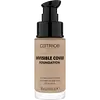What's inside
What's inside
 Key Ingredients
Key Ingredients

 Benefits
Benefits

 Concerns
Concerns

 Ingredients Side-by-side
Ingredients Side-by-side

Water
Skin ConditioningC15-19 Alkane
SolventIsododecane
EmollientAluminum Starch Octenylsuccinate
AbsorbentCellulose
AbsorbentGlycerin
HumectantPolyglyceryl-4 Oleate
EmulsifyingPolyglyceryl-4 Isostearate
EmulsifyingTrimethylsiloxysilicate
EmollientMagnesium Sulfate
Disteardimonium Hectorite
StabilisingAloe Barbadensis Leaf Juice
Skin ConditioningSqualane
EmollientPolymethylsilsesquioxane
Polyglyceryl-3 Polyricinoleate
EmulsifyingSodium Hyaluronate
HumectantTocopherol
AntioxidantPolyglyceryl-2 Tetraisostearate
EmollientSodium Gluconate
Skin ConditioningEthylhexylglycerin
Skin ConditioningPhenoxyethanol
PreservativeParfum
MaskingTetramethyl Acetyloctahydronaphthalenes
MaskingAlpha-Terpinene
PerfumingAluminum Hydroxide
EmollientCI 77491
Cosmetic ColorantCI 77492
Cosmetic ColorantCI 77499
Cosmetic ColorantCI 77891
Cosmetic ColorantWater, C15-19 Alkane, Isododecane, Aluminum Starch Octenylsuccinate, Cellulose, Glycerin, Polyglyceryl-4 Oleate, Polyglyceryl-4 Isostearate, Trimethylsiloxysilicate, Magnesium Sulfate, Disteardimonium Hectorite, Aloe Barbadensis Leaf Juice, Squalane, Polymethylsilsesquioxane, Polyglyceryl-3 Polyricinoleate, Sodium Hyaluronate, Tocopherol, Polyglyceryl-2 Tetraisostearate, Sodium Gluconate, Ethylhexylglycerin, Phenoxyethanol, Parfum, Tetramethyl Acetyloctahydronaphthalenes, Alpha-Terpinene, Aluminum Hydroxide, CI 77491, CI 77492, CI 77499, CI 77891
Ingredients Explained
These ingredients are found in both products.
Ingredients higher up in an ingredient list are typically present in a larger amount.
Aluminum Starch Octenylsuccinate is a synthetic powder used as an absorbent, thickener, and anti-caking agent.
As an absorbent, it is great at mattifying skin by soaking up the oil. This is why you'll find it in a range of products from makeup to moisturizers.
This ingredient is considered a modified starch. Starch can also be found naturally in plants.
One study from 1991 found that 5% of this ingredient enhanced titanium dioxide SPF by as much as 40%. The study found 1% titanium dioxide had a 5.6 SPF and adding 5% of aluminum starch octenylsuccinate boosted it to an SPF of 8.1
Although “aluminum” in an ingredient name can raise red flags for some consumers, the form and usage context matter significantly. For typical topical applications, there is no substantial evidence of health risks - such as cancer, neurotoxicity, or systemic “aluminum overload.”
Learn more about Aluminum Starch OctenylsuccinateCi 77891 is a white pigment from Titanium dioxide. It is naturally found in minerals such as rutile and ilmenite.
It's main function is to add a white color to cosmetics. It can also be mixed with other colors to create different shades.
Ci 77891 is commonly found in sunscreens due to its ability to block UV rays.
Learn more about CI 77891Ethylhexylglycerin (we can't pronounce this either) is commonly used as a preservative and skin softener. It is derived from glyceryl.
You might see Ethylhexylglycerin often paired with other preservatives such as phenoxyethanol. Ethylhexylglycerin has been found to increase the effectiveness of these other preservatives.
Phenoxyethanol is a preservative that has germicide, antimicrobial, and aromatic properties. Studies show that phenoxyethanol can prevent microbial growth. By itself, it has a scent that is similar to that of a rose.
It's often used in formulations along with Caprylyl Glycol to preserve the shelf life of products.
Sodium Hyaluronate is hyaluronic acid's salt form. It is commonly derived from the sodium salt of hyaluronic acid.
Like hyaluronic acid, it is great at holding water and acts as a humectant. This makes it a great skin hydrating ingredient.
Sodium Hyaluronate is naturally occurring in our bodies and is mostly found in eye fluid and joints.
These are some other common types of Hyaluronic Acid:
Learn more about Sodium HyaluronateWater. It's the most common cosmetic ingredient of all. You'll usually see it at the top of ingredient lists, meaning that it makes up the largest part of the product.
So why is it so popular? Water most often acts as a solvent - this means that it helps dissolve other ingredients into the formulation.
You'll also recognize water as that liquid we all need to stay alive. If you see this, drink a glass of water. Stay hydrated!
Learn more about Water